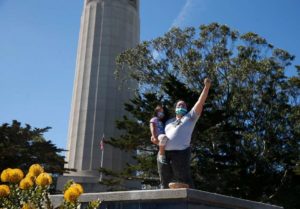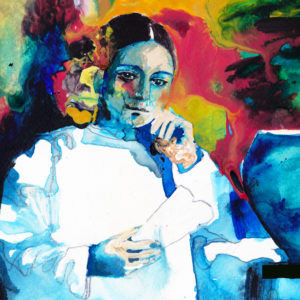Father Junipero Serra. Christopher Columbus. Sir Francis Drake. Even Francis Scott Key, who wrote the lyrics to the national anthem.
What do most of the statues being toppled across California have in common?

Mariposa Villaluna at Coit Tower after a crew from the city dismantled a statue of Christopher Columbus during the night. Photo: Paul Chinn / The Chronicle
They’re figures from history who supported white supremacy. And they’re all men.
So here’s a timely proposal. Why don’t we replace them with monuments memorializing the heroic women who’ve helped shape our state? The current protests have given us an opportunity for a deep cultural reckoning about how we want to see ourselves as people. The monuments that any society erects reflect its values. So let’s use this opportunity to address an unjust imbalance. Let’s honor more women, especially women of color.
There are shamefully few statues or monuments honoring California women so far, perhaps because out state’s statue-erectors have historically focused on early conquerors and explorers.
How many of the state’s monuments are dedicated to men versus women? In a list of California’s public statues on Wikipedia, only four out of forty-one are women — or about 10%. Out of the state’s current population of 39 million, just over 50% identify as females.
In San Francisco, widely considered to be one of the most progressive cities in the nation, out of 87 public statues, just two represent real women. The city passed a law about three years ago aimed at increasing the percentage of women honored in this way, but, perhaps predictably, nothing much changed.
A much-anticipated competition to honor the writer Maya Angelou with a piece of public art stalled with a disagreement at City Hall over which representation to pick. One of the competing artists, Lava Thomas, told the San Francisco Chronicle: “Artists deserve better, women deserve better, and Black women deserve better.”

Lava Thomas envisioned this modern design for a Maya Angelou sculpture, but a supervisor wants a traditional approach. Photo by Lava Thomas.
Yes, they do.
At the same time, the few statues of women that do exist are often chosen, not to honor the contribution that those women made as individuals, but because of their physical beauty or their relationships with powerful men.
One of those monuments is a 26-foot-high sculpture of Marilyn Monroe, capturing the moment from the Billy Wilder film, “The Seven Year Itch,” when a blast of air from a subway grate lifts her dress.
Titled Forever Marilyn and created by the artist Seward Johnson, is now in negotiations to be on permanent display in Palm Springs, provoking some discussion of objectification of the actress whose life ended in tragedy.
Likewise, the figure atop a pedestal in San Francisco’s Union Square was meant to represent Nike, the Goddess of Victory, but was modeled on a young Alma de Bretteville, considered a great beauty in her day. Not long after, she became the mistress and eventual wife of the wealthy sugar king Adolph Spreckels.

Photograph courtesy of Russel Ray
Instead of sexy movie stars and the paramours of wealthy men, perhaps we should start honoring California women who directed films, worked for social justice, and led a civil rights movement.
I can suggest a few possibilities. Bridget “Biddy” Mason, an African American woman born into slavery, she bought her freedom, became a successful investor, and helped found Los Angeles’s First African Methodist Episcopal Church.
Or Julia Morgan, the first woman to become a licensed architect in the state who helped erect some of California’s greatest architectural treasures.
Perhaps we should consider Tien Fuh Wu, a child servant at a brothel who’d been sold by her father, she eventually became a pioneering social worker in San Francisco who worked tirelessly for decades to help vulnerable girls and women in Chinatown.
We might even consider a living woman — Dolores Huerta – the 90-year-old civil rights worker and activist who, helped found the organization that would become the United Farmworkers and organize the Delano grape strike in 1965.

Tye Leung Schulze, courtesy of the Los Angeles Public Library
For more inspiring choices, you may want to join an online event June 30th co-hosted by the California Historical Society, Cal Humanities, and KQED, for a viewing and discussion of three short documentaries on women who changed California’s history.
One of the women I wrote about in The White Devil’s Daughters, Tye Leung Schulze, is the subject of one of the documentaries. She was an early advocate for trafficked women. I’m interviewed in the documentary about her life, as is her grandson, Ted Schulze.
The other two women highlighted in the documentary shorts are Lois Weber, the first woman to direct a feature-length film, and Charlotta Spears Bass, a newspaper editor, Civil Rights crusader, and the first African American woman to be nominated for Vice President.
It’s about time we start looking for other heroes to look up to. And they shouldn’t all be men. As Huerta might say, Si, se puede!


